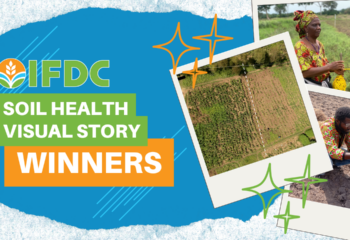
By: Dr. Shree Prasad Vista, Nepal Agricultural Research Council (NARC); Dr. Yam Gaihre, International Fertilizer Development Center (IFDC); Dr. Naba Raj Pandit, International Maize and Wheat Improvement Center (CIMMYT)
The time has come again to talk about the importance of soil, the habitat for more than 2 million living species. The soil is the foundation for all forms of life, and their existence depends on the quality of soil. To acknowledge this, we observe World Soil Day annually on December 5. This celebration started when the United Nations General Assembly declared December 5, 2014, the first official World Soil Day. This year, we celebrate World Soil Day with the theme “Keep Soil Alive, Protect Soil Biodiversity.”
Soil plays a critical role not only in improving the livelihoods of humans but also in helping billions of other plants, animals, and microorganisms. Many people are not aware that soil is a living thing and that 1 gram of soil contains billions of organisms, including microorganisms such as bacteria and fungi. These organisms are critical to our survival. However, fewer than 1% of these have been identified, and we only know the roles of fewer than 1% of known species. Soil is the greatest reservoir and the last frontier of biodiversity. Most antibiotics, which have increased human life expectancy, were prepared from microorganisms in the soil. The soil biosphere controls the cycling of most major plant nutrients, such as carbon, nitrogen, phosphorus, and sulfur. Soil microbes, in association with plant roots, can fix nitrogen, help sequester carbon, and contribute to climate resiliency. Without the active role of microorganisms, soil cannot supply nutrients that are essential for plant growth and development and, consequently, no food for human or animals could be produced.
Each species in the soil has a unique role in maintaining the food chain and ecological balance in nature. A disturbance in the food chain would irreversibly impact the lives of many different species, including humans. Soil acts as the reservoir of carbon; it holds about 80% of the total carbon present in terrestrial ecosystems. The abundance and diversity of living organisms in the soil are the key drivers of soil ecosystems that control soil fertility, nutrient cycling, and greenhouse gas balance. In addition, microorganisms help clean the environment by decomposing wastes, converting them into soil, detoxifying contaminated soil, and making it suitable for the existence of other organisms, including plants, animals, and humans.
Soil and human health cannot be improved without sustaining soil biodiversity, which is currently declining due to the excessive use of agrochemicals and imbalanced use of chemical fertilizers. As carbon is the main food source for soil microorganisms, the organic matter of the soil must be improved to keep soil biologically active. However, the organic matter content of the Nepalese soil, particularly in the Terai, is low and dwindling (Figure 1). The soil organic matter in this region has decreased due to lower use of organic inputs combined with the imbalanced use of chemical fertilizers. The reduction of organic carbon in soils, coupled with the use of heavy machinery, is diminishing the microbial population and their activities. While mechanization is necessary to increase farm profits and reduce the drudgery of cultivating a farm, it has adverse effects on soil, such as compaction, which can reduce microbial activity and diversity. With the intensification of agriculture, the use of organic inputs is waning, while that of chemical fertilizers and agro-chemicals is rising; this situation poses a huge challenge to sustaining soil biodiversity.

Thus, conservation of soil biodiversity is urgently needed for sustainable improvement of soil health and crop productivity to alleviate the current food insecurity and poverty issues. Farmers must adopt efficient management practices, such as judicious and balanced use of chemical fertilizers, in combination with organic inputs, proper irrigation, correction of soil acidity with liming, green manure, and reduced soil tillage practices; these practices can improve soil organic matter content and protect soil biodiversity. Other soil conservation measures, such as the use of legume crops, cover crops, catch crops, crop rotation, and agroforestry practices, can enhance soil biological activities (microbes and macro-fauna), which in turn improve soil physicochemical properties to maintain soil health. In addition, adoption of integrated pest management and use of inoculation with rhizobium, mycorrhizae, actinomycetes, etc., can directly promote biological activity and diversity in the soil. In recent years, the use of biochar and improved compost have been beneficial in supplementing the role of chemical fertilizers and improving soil biological, physical, and chemical properties, thereby maintaining soil biodiversity and enhancing crop productivity.
It is our collective responsibility to create awareness of the importance of soil biodiversity and its role in improving soil health, crop productivity, and human livelihoods. Healthy soil makes the environment healthy, and a healthy environment makes people healthy. Let us keep soil biologically active by protecting the biodiversity, so that the next generation can enjoy healthy lives.




